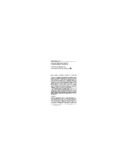Effect of pollarding frequency on biomass of Erythrina poeppigiana as a coffee shade tree
Description
Publicado también en Agroforestry SysteMON v. 4 (1986) p. 145-162.
Abstract
The use of pollarded Erythrina poeppigiana as shade tree in coffee plantations is apparently and old practice in Costa Rica. The tree is not native to this country but was introduced between late 19th and 20th century and was rapidly dispersed in the coffee and cacao areas. Currently, the Erythrina tree is widespread in the Turrialba valley (elevation 600-1300 m) and in the Central Valley (elevation 1200 m) where the species is always associated with present or past coffee crops. Pollarding carried out by Costa Rican farmers constitutes a long dated and functional practice, hence the objective of this study was to evaluate the amount of biomass produced by pollarding of Erythrina poeppigiana used as shade in coffee crop planted at a density of 280 trees/ha under different pollarding frequencies. Results showed that by pollarding once a year, 18.470 kg of dry matter per hectare are produced with two pollarding per year 11.800 kg/ha are produced and with three pollardings per year 7.850 kg/ha are produced. The total amount of nitrogen removed is very similar for pollarding once and twice a year, but is lower for three times a year. The amount of nitrogen removed was approximately 230 kg/ha/year in the first two cases and 170 kg/ha/year in the last one. The above observations suggests that a considerable supply of nutrients exists in the systeMON with shade trees, when they are periodically pollarded. Finally some conclusions and follow up activities related to research on the species are suggested, such as higher biomass production techniques, appropriate planting practices, selection of genetic material, nutrient depletion when biomass is harvested, conversion of leaves to marketable feed sources (flour, pellets), alley cropping and green manure production and restoration of degraded areas and improductive savannas by planting large cuttings that would improve the soil by adding biomass and shade out undesirable grasses
Keywords
Publisher
Centro Agronómico Tropical de Investigación y Enseñanza (CATIE), Turrialba (Costa Rica)
URI (Permanet link to cite or share this item)
https://repositorio.catie.ac.cr/handle/11554/1478Collections
- Publicaciones y documentos [4419]


